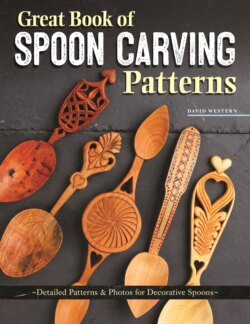Читать книгу Notes from a Swedish Kitchen - David Western - Страница 7
На сайте Литреса книга снята с продажи.
What Is Romantic Spoon Carving?
ОглавлениеBeginning in the early to mid-1600s, it became common practice for young, single men throughout Europe to create ornately embellished, carved wooden love tokens that would be given as gifts to the young women who had caught their eye or captivated their hearts.
Often, these tokens tended to reflect regional trades, pastimes, or specialties by taking the form of decorated tools, with tools for knitting, lacework, or milking being particularly popular. In several regions, however, the spoon became the dominant courting, wedding, and gifting love token, eventually finding popularity from the Arctic Circle to the Carpathian Mountains.
Little is known of why the spoon became such a popular love token; explanations range from its simplicity to carve and its portability, to the urge of common folk to mimic the gentry’s burgeoning use of fancy metal spoons.
The spoons themselves were given for a variety of romantic reasons, ranging from simple statements of passionate interest through to the symbolic sealing of marital unions. Ardent amateurs and impartial professionals alike carved them. Often, the spoon acted as a résumé, showing the young woman and her family that the young man was skilled and tenacious or that he was financially secure enough to afford the services of a professional. A well-carved spoon clearly showed the carver’s abilities and his willingness to see a difficult task through to a proper conclusion, traits that were favorably viewed. However, a poorly carved offering would most certainly have not assisted the young man in winning approval with anyone.
Although the vast majority of romantic spoons are now carved by machinery in a commercial setting, more and more hand carvers are realizing just how wonderful a project they are. Easily crafted from limited materials and with a simple selection of tools, a spoon can encapsulate a great deal of symbolic imagery and tell a real story of love or admiration. They are beautifully suited as gifts for a wide range of circumstances ranging from weddings and anniversaries to birthdays and christenings.
Once carved only by men, now anyone can carve romantic spoons, and their range of purpose has expanded significantly with a vast array of symbolic images now utilized to make ever more meaningful designs. Whether you’re a complete beginner or an advanced carver, spoon carving offers you an opportunity to create beautiful and deeply meaningful artwork from basic tools and minimal material.
Three antique Welsh lovespoons from the mid to late 19th century.
The variety of designs that can be found on a romantic spoon’s handle is rich and infinite.
This Book’s Goals
By creating this book, my intention is to fulfill three main goals. The first is to address two dismal shortages in the romantic spoon carving realm. Currently, there is an acute lack of published historical information regarding the romantic spoon, as well as an equally dire lack of spoon designs that are accurate to period and place; this book takes a large step toward filling that void.
The second goal is to give interested woodcarvers, artists, and enthusiasts an opportunity to study a mixture of design styles from the period of 1650–1900. It allows them to see firsthand the various techniques and styles used by the Northern European spoon carving community and to make their own versions of classic romantic spoon designs.
The third goal is to amply illustrate that the field of romantic spoon carving is much broader and richer than is often thought. Moving beyond the notion of all romantic spoons being “lovespoons,” this collection delves into feeler, courting, wedding, novelty, and festival spoons and explains the variety of purposes for which romantic spoons were historically given and used.
